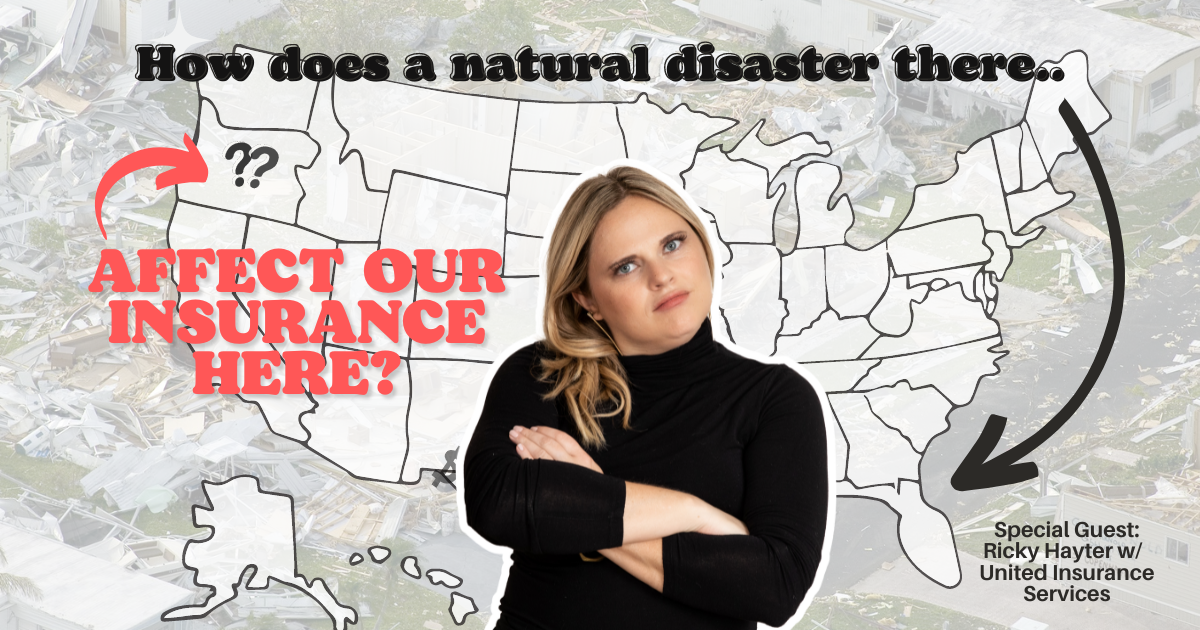Natural disasters have a profound impact on various aspects of our lives, from property damage and displacement to economic repercussions. One area where their effects are particularly felt, yet often overlooked, is the realm of insurance. In this week’s market update we have a special guest, insurance expert Ricky Hayter to shed light on how natural disasters impact insurance companies and, subsequently, how those impacts trickle down to homeowners, even those far away from the disaster-stricken areas. This article delves into the insights shared during the discussion and explores the broader implications of how natural disasters affect everyone’s insurance, focusing on the context of the Pacific Northwest.
Understanding Reinsurance: The Safety Net for Insurers
Ricky explains that insurance companies have their own safety net, known as reinsurance. Reinsurance is essentially insurance for insurance companies. When a catastrophic event like Hurricane Ian in Florida or wildfires in California causes significant losses, insurance companies turn to their reinsurance providers to cover those costs. This dynamic means that when insurance companies’ costs rise due to these disasters, those increased expenses are eventually passed down to policyholders.
The Domino Effect: Nationwide Impact
While it might seem logical to assume that disasters in one region only affect insurance rates in that area, Ricky emphasizes that the impact is actually nationwide. The insurance companies involved are often national carriers, spreading their risk across multiple regions. When they face heavy losses in one part of the country, the financial strain ripples through their entire operation, resulting in rate increases for policyholders across the nation.
Implications for Homeowners in High-Risk Areas
The discussion shifts to how homeowners in high-risk areas, such as wildfire-prone zones, are affected. Insurance companies are increasingly cautious about accepting risks in these zones to prevent future losses. As a result, homeowners may find it more challenging to secure affordable coverage from mainstream carriers. Ricky advises those in high-risk areas to work with experienced insurance brokers who can help them navigate this challenge and find coverage options tailored to their needs.
Navigating the Insurance Landscape
If homeowners are dropped by standard insurance carriers due to their location in high-risk zones, Ricky reassures them that alternative options exist. However, these options might come from non-standard carriers, which carry slightly more risk due to potentially lower reserves. While they might not cover minor issues as comprehensively, they are still there to provide protection against major catastrophes.
Mitigating the Impact
Ricky underscores the importance of utilizing insurance for significant losses and recommends avoiding making claims for minor issues. Keeping insurance scores high and working with insurance brokers who understand the nuances of the industry can help homeowners maintain stable coverage at reasonable rates.
Future Outlook and Conclusion
So, is the current state of the insurance landscape is the new normal? Ricky explains that insurance operates in cycles of ups and downs, influenced by various factors including natural disasters, economic conditions, and other market dynamics. While the present moment presents challenges due to a confluence of factors—such as the frequency of catastrophic losses and the aftermath of the COVID-19 pandemic—Ricky suggests that this state will likely stabilize over the coming years. In the meantime, homeowners are encouraged to partner with knowledgeable insurance brokers to make informed decisions that minimize the impact of these fluctuations.
Final Thoughts
Thanks to the insights provided by Ricky we have a better understanding on the often underestimated connection between natural disasters and insurance rates. The far-reaching effects of catastrophes in one region extend to homeowners across the country, including those living in relatively safer areas. As individuals, understanding these dynamics empowers us to make informed decisions about our insurance coverage, while collectively acknowledging our interconnectedness in the face of natural disasters and their aftermath. By working with experienced insurance professionals and adopting strategies that align with the broader insurance landscape, homeowners can navigate these challenges and secure the protection they need in an ever-changing world.

